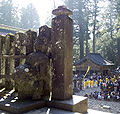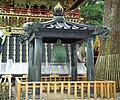日光市
Jump to navigation
Jump to search
Galego: Nikko é unha cidade da prefectura de Tochigi, Xapón, destino popular dos turistas xaponeses.
Stereoptic views, c. 1900
[edit]Nikko Toshogu
[edit]Torii and pagoda
[edit]English: Everything below the stairway leading up to the Omote-mon. The path leads up a gentle slope and passes under a tall torii (Ichi-no-torii). To the left stands a five-story pagoda. The path leads straight past the pagoda to the foot of a steep stone starway. At the top stands the Outer Gate (Omote-mon).
-
Outer torii. Beyond it, the Outer Gate is visible.
-
Pagoda and torii at Toshogu, Nikko
-
Pagoda at the Toshogu
Omote-mon, Suibansha, Kyōzō, Other
[edit]English: Everything from Omote-mon to stairway leading up to Yomei-mon, including the Sacred Stable with the carvings of the Three Wise Monkeys and many lanterns.
The Outer Gate, or Omote-mon, stands at the top of the first staircase. Statues of the guardian gods occupy the niches to the left and right on the outside. On the inside are statues of lions. The path goes straight for a short distance. Stone lanterns stand to both sides.
The path turns left toward the Sacred Stable. Across the path are three storehouses. The one nearest the Outer Gate is the Shimojinko; next is the Nakajinko; the last is the Kamijinko. Carvings of elephants and lions decorate the gables of the Kamijinko. These animals were unknown in Japan, and the sculptor had to imagine them. Also in this courtyard are a bronze torii (Ni-no-torii) and the Kyōzō, or scripture repository.-
A-Un statues in Outer Gate(Un reversed left to right)
-
Statue of A (Niō) in niche on outer facade of Outer Gate
-
Statue of A (Niō) in niche on outer facade of Outer Gate
-
Statue of A (Niō) in niche on outer facade of Outer Gate
-
Statue of Un (Niō) in niche on outer facade of Outer Gate
-
The same statue in 1993.
-
Outer Gate viewed from inside shrine
-
Chinese Lion in niche on inner facade of Outer Gate
-
Chinese Lion in niche on inner facade of Outer Gate
-
Decoration in Outer Gate
-
Shimojinko. The Outer Gate is to the right; the Nakajinko is to the left.
-
Nakajinko. The Shimojinko is to the right; the Kamijinko to the left.
-
Kamijinko. Beyond it is the Bell Tower.
-
Kamijinko
-
Lion and elephant carvings beneath roof. Kamijinko.
-
Lion and elephant carvings beneath roof. Kamijinko. Behind the photographer is the Sacred Stable with the carvings of the monkeys.
-
Kyōzō (sutra library)
-
Kyōzō. Beyond it stands the Drum Tower.
-
Participants in the procession of a thousand warriors pass the Kyōzō.
-
English: Bronze torii. Beyond it stand (l to r) Drum Tower, Yomeimon (at top of stairs), Bell Tower.
English: After walking under the bronze torii, the visitor climbs two of stairs going up toward the Yomeimon. Looking back from the top of the first set of stairs, one can see the sacred stable to the left, the bronze torii, and the suibansha to the right.
-
View looking back from top of first set of stairs. The bronze torii is flanked by a minor building to the left and beyond it the sacred stable, and the Suibansha on the right. Out of sight to the left are the storehouses: Kamijinko, and beyond it, Nakajinko and Shimojinko. Out of sight to the right is the Kyōzō.
Sacred stable and three wise monkeys
[edit]English: The sacred stable stands to the left of the path. Panels above eye level have carvings of monkeys, including one especially famous panel with the wise monkeys that hear, speak, and see no evil.
-
Sacred stable. The carvings of the monkeys are visible.
-
Panoramic view of carvings
English: After passing the stable, the path turns right. It leads past the covered cistern (mizuya) where visitors wash. Next is a metal torii, followed by another steep staircase.
Lanterns
[edit]Lanterns, everywhere in Toshogu
-
Stone lanterns at Toshogu
-
Iron lantern
-
Rotating lantern
-
Crest of Tokugawa family on lantern
-
Crest
-
Lantern in snow
Bell tower, drum tower, Yakushido, Yomeimon 陽明門
[edit]English: Two towers flank the path at the top of the stairs: the bell tower to the right, and the drum tower to the left. The Yakushido (or Honjido) is beyond the drum tower to the left. It has the "crying dragon" painting. Ahead is another stairway, and at the top, the Yomeimon.
-
Looking back from the top of the stairway at the Bell Tower level, one sees this komainu and beyond it the sacred stable.
-
This historical stereo pair shows the same komainu and sacred stable.
Bell tower, drum tower, Yakushido, bronze bell, bronze lantern
[edit]-
Bronze bell. Behind it is the bell tower.
-
Bell adjacent to Bell Tower
-
Tokugawa family crest on roof of bell tower
English: The Yomeimon is a famous gate within the precincts of the shrine. On the outside of the gate, to the left and right, are statues of archers. The walls on both sides have panels with carvings of birds and trees in deep relief. On the inside of the gate, to the left and right, are statues of lions. Pillars inside and outside are painted white and carved with the same motif. One pillar has the motif upside-down.
-
Yōmeimon circa 1860-1900
-
Yōmeimon at Toshogu
-
Yōmeimon (view from outside the gate)
-
View of Yōmeimon from inner courtyard looking out
-
View of Yōmeimon looking in
-
Yōmeimon (view from within the inner courtyard)
-
Carving of lion on Yōmeimon (inside)
-
Carvings alongside Yōmeimon (outer facade)
-
Detail of carving on Yōmeimon(outer facade)
-
Joinery under roof of Yōmeimon
-
Decoration above Yōmeimon
-
Decoration on outer facade of Yōmeimon above the gate
-
Carvings in Yōmeimon
-
Carvings in Yōmeimon
-
Statue of lion, rear (interior) of Yōmeimon
-
Archer statue (outside)
-
Archer (outside, right)
-
Pillar with upside-down motif. A visitor rubs it for good luck. (Inside of Yōmeimon.)
-
Upright motif on pillar
-
Decorative carving on inner facade of Yōmeimon
English: Beyond the Yomeimon is the inner courtyard.
Inner courtyard: Mikoshi building, Karamon, Haiden, Honden, Kaguraden
[edit]English: Everything in or near the courtyard within the Yomei-mon, prior to entering the inner shrine. The Yomeimon is the gate to the inner courtyard. The visitor who passes the Yomeimon sees, in this courtyard, to the left, is a building (the Shin'yosha, 神輿舎) housing the mikoshi, portable shrines. Ahead is the Chinese Gate, or Karamon, with figures in white. Through it is visible the Oratory, or Haiden. Beyond that is the Main Hall, the Honden.
-
Karamon (Chinese gate), Haiden (prayer hall), Honden (main hall)
-
Karamon
-
Karamon
-
Karamon
-
Mikoshi building
-
Mikoshi building
-
Kaguraden, the hall for sacred dances
-
Yomeimon (right) and Kaguraden
English: Visitors turn right, toward the Sleeping Cat.
Sleeping cat and inner shrine
[edit]English: The Sleeping Cat, Nemurineko, is a carving above a gate. It is attributed to the sculptor Hidari Jingoro. After passing through the Sakashitamon, visitors ascend the hundreds of stone stairs, amid the towering cryptomeria trees, to the inner sanctuary. At the top of the stairway is a torii with calligraphy by Emperor Go-Mizunoo.
-
Sleeping cat carving attributed to Hidari Jingoro at Toshogu, Nikko
-
Tablet with calligraphy by Emperor Go-Mizunoo
-
Paper offerings
-
Cast gate in front of mausoleum
-
Urn containing remains of Tokugawa Ieyasu
Festival
[edit]-
Mikoshi (portable shrine) at autumn festival (matsuri) of Toshogu, Nikko
-
Procession of a thousand warriors, Toshogu, Autumn festival
-
Banners at procession at Toshogu
-
Tokugawa crest on banner in front of pagoda at Toshogu
-
Procession of a thousand warriors
-
Horse in caparison for spring festival
-
Kids take a break during the fall festival at Toshogu
-
Preparing for the procession of a thousand warriors
-
Participants in the Procession pass the Kyozo
Nikko Rinnoji
[edit]-
Shodo Shonin
-
Rinnoji
Futarasan Jinja 二荒山神社
[edit]-
Building (probably haiden)
-
Building housing mikoshi
-
Hie Shrine
-
Chinese-style lantern, the Bake-doro ("Ghost Lantern")
-
Daikoku-den 大黒殿
-
Statue of Daikokuten 大黒天
-
Mitomo Jinja
-
Other buildings at Futarasan Jinja
-
Sacred bridge (Shinkyo)
-
Gate to Futarasan Shrine
-
Honden (main hall)
City
[edit]-
Main street, Nikko
-
World Heritage marker below Toshogu
-
World Heritage marker outside Nikko Station
Waterfalls, Lakes, Rivers, Mountains
[edit]-
Kegon Falls
-
Kegon Falls
-
Believed to be Ryūzu Falls
-
Jakko Falls
-
Shiraito Falls
-
Lake Chūzenji in Nikko
-
Lake Chūzenji
-
Statues of Jizo along Daiya River, Nikko
-
Mountain, believed to be Nantai, Nikko



















































































































